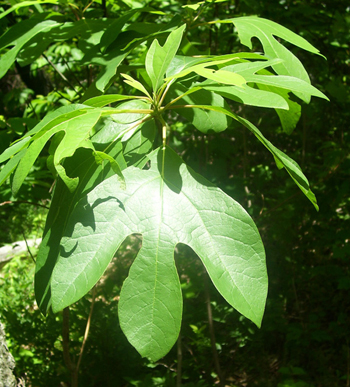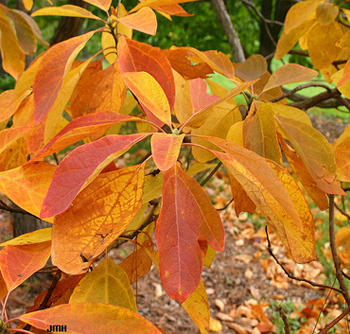Contents:
Common Names | Parts Usually Used | Plant(s) & Culture | Where Found | Medicinal Properties
Legends, Myths and Stories | Uses | Formulas or Dosages | How Sold | Warning | Bibliography
Scientific Names
 |
- Sassafras officinale L.
- Sassafras albidum
- Laurel family
Common Names
- Ague tree
- Cinnamon wood
- Saloip
- Saxifrax
Parts Usually Used
Bark of the root
Back to Top
Description of Plant(s) and Culture
 |
appear on twigs before leaves and are followed by dark, shiny blue berries. In places it is also grown as an ornamental.
The stem of sassafras albidum, which is usually 10 to 40 feet high but sometimes reaches 125 feet, is covered with rough, grayish bark. The leaves alternate, downy on the lower side, and variable in shape from ovate to elliptic, entire or three-lobed. The small, yellowish-green flowers grow in racemes, blooming before the leaves appear. The fruit is pea-sized, yellowish-green drupe, turns blue-black with 1 seed.
Back to Top
Where Found
Sassafras is a native North American deciduous tree which can be found in woods from Ontario to Michigan, and south to Florida and Texas to east Kansas. Grows in poor soils.
Back to Top
Medicinal Properties
Aromatic, stimulant, alterative, diaphoretic, diuretic, antiseptic.
The bark of sassafras root contains a volatile oil, resin, wax, camphor,
fatty matter, albumen, starch, gum, lignin, tannic acid, salts, and
a decomposition product of tannic acid known as sassafrid.
Back to Top
Legends, Myths and Stories
Columbus is said to have sensed the nearness of land from the strong scent of sassafras. There is an old story that tells of the scent of sassafras carried out to sea by the wind; it helped Columbus to convince his mutinous crew that land was near. The crew found the Native Americans using the bark of the root for beverage, medicine and flavoring. This new flavor had an appeal and for more than 200 years it was exploited in disease-ridden Europe as a panacea for many ills. At one time Sir Walter Raleigh controlled a monopoly of all imports on this new botanical. Later, the Creoles adopted this flavoring for soups and sauces.
The tree and tales of its values, learned from the Indians by Spanish explorers in Florida, were carried to Europe. Sassafras became one of the first commercial exports from the new land. When the Europeans first settled North America, sassafras was a major export. The Plymouth colony was in part founded on speculation of the sassafras exports.
The Encyclopaedia of Arts and Sciences wrote in 1798, “Some people boil sassafras with beer which they are brewing, because they believe it wholesome. For the same reason, the bark is put into brandy either whilst it is distilling or after it is made.”
“Swedes wash and scour the containers in which they intend to keep cider, beer or brandy with water in which sassafras root or its peel has been boiled; which they think renders all those liquors more wholesome.” This from Travels Into North America, by P. Kalm, 1772.
In making green tea, drop in a piece of sassafras root and see the good taste it makes. Good iced, too.
The Pennsylvania Dutch place a piece of sassafras root with their applesauce or applebutter when they cook it, to enhance the flavor and aroma. Many housewives try to keep dried fruit for winter use, but the worms often got into it. Then they learned to put a piece of sassafras root in among the dried fruit and the worms never bothered again. In this way, the dried fruit may be kept for years. A handful or two of the bark mixed with a bushel of dried fruits to keep out insects, also will add flavor to the fruit.
American Indians, it is said, used an infusion of sassafras root to bring down a fever. Also, they smoked, in a pipe, the bark of the root, which is highly aromatic.
The oil of sassafras is used in the cosmetic and perfume industry.
One old herbalist physician advised, “those who wish to break themselves of chewing tobacco, will find the pith of sassafras an agreeable substitute.” Wonder if this would work for smoking tobacco as well.
Buyer beware: sometimes sassafras is sold that is the inner wood, which is worthless. Resembling lumber shavings and is very light in color. Good sassafras has a deep red color, agreeable odor and a rich flavor found only in the peeled outer bark of the root. To get this outer bark of the root entails considerable labor and expense. Be sure you know what to buy. Quality goes much further.
Back to Top
Uses
Hot infusion of dried root bark has been used to treat rheumatism, arthritis, gout, and as a wash for skin irritations, eczema, acne, and ulcers.
Tea of the bark of the root was used by old timers as a spring tonic, to cleanse the blood.
Good to flavor other herbs that have a disagreeable taste. Will relieve gas, ague, and colic. Taken warm, it is remedy for spasms. Good wash for inflamed eyes. Oil of sassafras is good for the toothache. Used as a wash, good for varicose ulcers.
The bark of the roots contains a volatile oil that has anodyne and antiseptic properties.
Back to Top
Formulas or Dosages
Take no more than a week at a time.
Infusion: steep 1 tsp. bark of root in 1 cup of water. Take 1 cup per day.
Tincture: A dose is 15 to 30 drops.
A remedy for skin disorders such as eczema:
- Red clover flowers 2 oz.
- Burdock root 1 oz.
- Blue flag root 1 oz.
- Sassafras root bark 1/2 oz.
Place 1/4 of the mixture in 1 pint of cold water, bring to a boil, simmer for 20 minutes, strain when cold. Dose: One wineglassful 3 times per day, until improvement is apparent.
Back to Top
How Sold
Tincture
Back to Top
Warning
Doubt has arisen as to the safety of sassafras since it is thought to contain potential carcinogens. Safrole, found in the oil of sassafras, is the carcinogenic property. Banned by FDA. Yet the safrole in a 12 oz. can of old-fashioned root beer is not as carcinogenic as the alcohol (ethanol) in one can of beer.
Back to Top
Bibliography
Herbal Gardening, compiled by The Robison York State Herb Garden, Cornell Plantations, Matthaei Botanical Gardens of the University of Michigan, University of California Botanical Garden, Berkeley., Pantheon Books, Knopf Publishing Group, New York, 1994, first edition
![]() The Herbalist Almanac
The Herbalist Almanac, by Clarence Meyer, Meyerbooks, publisher, PO Box 427, Glenwood, Illinois 60425, copyright 1988, fifth printing, 1994
![]() Eastern/Central Medicinal Plants
Eastern/Central Medicinal Plants, by Steven Foster and James A. Duke., Houghton Mifflin Company, 215 Park Avenue South, New York, NY 10000
![]() The Herb Book
The Herb Book, by John Lust, Bantam Books, 666 Fifth Avenue, New York, NY. copyright 1974.
 An Instant Guide to Medicinal Plants
An Instant Guide to Medicinal Plants, by Pamela Forey and Ruth Lindsay, Crescent Books (January 27, 1992).
![]() Indian Herbalogy of North America
Indian Herbalogy of North America, by Alma R. Hutchens, Shambala Publications, Inc., Horticultural Hall, 300 Massachusetts Avenue, Boston, Massachusetts 02115, 1973
 The Magic of Herbs in Daily Living
The Magic of Herbs in Daily Living, by Richard Lucas, Parker Publishing Co. (1988).
![]() Back to Eden
Back to Eden, by Jethro Kloss; Back to Eden Publishing Co., Loma Linda, CA 92354, Original copyright 1939, revised edition 1994
 Old Ways Rediscovered
Old Ways Rediscovered, by Clarence Meyer, Meyerbooks, publisher, PO Box 427, Glenwood, Illinois 60425, published from 1954, print 1988
![]() The Yoga of Herbs: An Ayurvedic Guide to Herbal Medicine
The Yoga of Herbs: An Ayurvedic Guide to Herbal Medicine, by Dr. David Frawley & Dr. Vasant Lad, Lotus Press, Twin Lakes, Wisconsin, Second edition, 1988.
![]() Planetary Herbology
Planetary Herbology, by Michael Tierra, C.A., N.D., O.M.D., Lotus Press, PO Box 325, Twin Lakes. WI 53181., Copyright 1988, published 1992
 The Rodale Herb Book: How to Use, Grow, and Buy Nature’s Miracle Plants (An Organic gardening and farming book)
The Rodale Herb Book: How to Use, Grow, and Buy Nature’s Miracle Plants (An Organic gardening and farming book), edited by William H. Hylton, Rodale Press, Inc. Emmaus, PA, 18049., 1974
